論説

概要
- Within the consumer products industry, different companies will feel disruption differently and at a different pace across the value chain.
- As business leaders try to plan for the future without knowing the endgame, those that survive and outperform will envision the business both “today forward” and “future back.” They also will focus on raw consumer needs and quantify the disruption for better-informed decisions.
- Instead of developing a pipeline of projects with set timelines and milestones, the best companies will take a more flexible “waves” and “stepping-stones” approach that allows them to move forward but also to pivot as needed—and then to move forward again.
The disruption that has upended the retail, tech and media industries has reached consumer products relatively late, but it is hitting the industry with full force (see Figure 1). Among the most dramatic examples of what’s at stake: The entries of Harry’s and Dollar Shave Club led to a market share drop from 70% in 2010 to 54% in 2016 at Gillette, which also saw an average 12% price decrease in 2017.
Not long ago, it would have been unimaginable that a start-up could create a running shoe to compete against the retail presence and manufacturing power of a giant such as Adidas. Today, brands such as Allbirds shoes and Bonobos menswear, with few if any of the industry leaders’ conventional assets, have quickly become fashion leaders by using viral marketing and direct sales to consumers. Or consider how start-up Glossier shook up the cosmetics category, raising more than $86 million since its 2013 launch. The young company uses various social media platforms and apps to connect with and understand a community to derive consumer-driven innovation. Glossier’s use of rapid prototyping and customization based on consumer feedback works: The company sells one of its signature “Boy Brow” eyebrow shapers every minute.
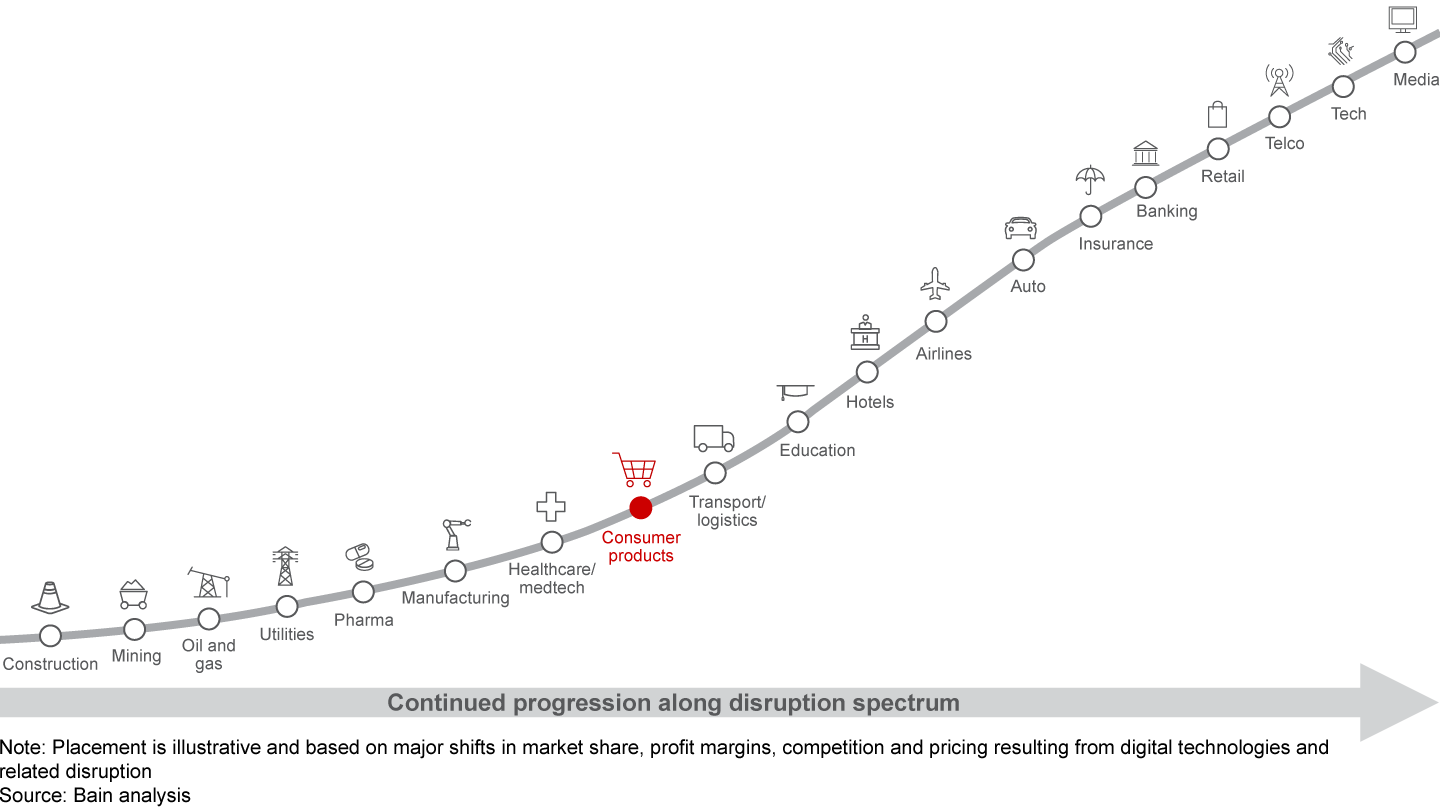

Within the consumer products industry, different players feel disruption differently and at a different pace across the value chain and categories. For example, while some categories, especially apparel, toys and pet care, are further along on the disruption spectrum, disruption moves at a slower pace within other categories, such as oral care and beer. But that is quickly changing. The undeniable reality is that no category is immune to technological advancements and rapidly evolving consumer expectations, and regardless of disruption’s pace, all companies need to prepare (see the Bain Brief “Overcoming the Existential Crisis in Consumer Goods”). That means companies in categories such as food and beverage need to learn from more disrupted categories.
It is understandable that business leaders feel paralyzed at first, not knowing how to react, where to play offense and where to play defense. A fundamental hurdle is that most companies plan ahead by following a tried-and-true formula—that is, they look backward. Instead, the incumbents that survive and outperform will be those that find a way to put themselves one step ahead by looking into the future.

Preparing for Disruption in Consumer Products
Disruption happens fast. Here’s how to prepare.
As disrupters rapidly rewrite the old rules, every consumer products company, leadership team and board of directors feels pressured to answer this question: How do we make progress when we don’t know the endgame? A disruption radar helps companies find the answer not only by tracking new angles of category disruption and increasing the focus on consumer needs but also by providing a more analytical methodology for identifying disruptions and gauging their impact. Three big ideas help companies to develop the components of a winning strategy amid unprecedented disruption.
No. 1: Envision “today forward” and “future back.” The first big idea is to envision the business both “today forward” and “future back.” Today forward uses existing digital technology and management approaches to make a business better, faster and cheaper right now. That means zeroing in on the three to five focused, well-defined initiatives that can get the firm moving in the direction of its future. Every organization has its dreamers and doers, and today forward is the path of the doers.
Future back is the opposite. It involves imagining the future and then working on the steps required to position a company to compete in 10 or 20 years, including how to make progress today in order to make that happen. It means defining a vision for the industry and company, often inspired by a fundamentally underserved consumer need or an emerging and breakthrough technological solution. Future back is the domain of the dreamers.
One of the major obstacles to adopting a today-forward and future-back approach is that consumer goods incumbents customarily build large fact bases before they act, and they focus on the quarterly cycle, often pursuing short-term results at the expense of long-term investment. Most companies celebrate the doers, who excel at tactical execution of short-term initiatives. Amid disruption, however, business leaders must find a way to complement the doers with dreamers—namely, those who think long-term, are comfortable with the unknown and can navigate an environment in flux.
Combined, today forward and future back convey a sense of long-term direction to employees and other stakeholders, while at the same time articulating the first steps the organization can take to start moving in that general direction. In effect, it allows companies to build a faster horse while simultaneously imagining the car.
No. 2: Focus on raw consumer needs. Most brands instinctively look at the future from a category or product perspective, but that kind of thinking becomes outmoded as category lines blur and as products, services and experiences merge. Winning brands instead learn how to unleash innovation by rediscovering the raw need that the business serves.
Many consumer goods companies fall in love with their products, which is natural and understandable. But a product, no matter how great, is really just the temporary answer to the raw need that a business serves. Raw need is the essence of what a consumer values, independent of how a company addresses that need.
Innovators have a knack for articulating this need and building their businesses around it. Unencumbered by a set of legacy assets and capabilities holding them back, they zero in on creative solutions that wow consumers. With a new breed of competitors rediscovering consumers’ raw needs and creating innovative ways to address them, companies must get comfortable with a challenging idea: The consumer experience you deliver in the future may be quite different from the one you provide today.
Consider how Baby Tree, the largest maternity and parenting online platform in China, “listens” to what its 144.1 million total active monthly users discuss and then enlists a private label manufacturer to produce and launch a Baby Tree branded product to address consumer pain points. Domino’s has leapfrogged its pizza competitors by pursuing a simple mandate from the CEO, who wanted the customer to be able to order pizza while waiting at a stoplight. A clear raw need―convenient pizza―led to a business model enabled by technology.
Many incumbents started with a unique insight or model for meeting the raw consumer need at one point, but over time, they create impediments that obscure that need and expose the business to disruption. Consumer goods companies can learn how to reboot by looking at companies in industries that are further out on the disruption spectrum. For example, as comparative store sales began to decline, Walmart started to make changes, refocusing on its raw consumer need of saving time and money. That meant embracing new digital technologies and affirming its focus on e-commerce. The retailer made several e-commerce acquisitions, and its online sales grew by 44% in 2017.
At the same time, Walmart recognized it could use its existing brick-and-mortar stores, historically its biggest asset, to address consumer needs and help fuel the company’s e-commerce growth in the US. As of early 2018, Walmart offered in-store pickup for groceries in about 1,200 US stores, with plans to add roughly 1,000 more locations during the year. By the end of 2018, it offered grocery delivery in more than 100 metropolitan areas, covering 40% of US households. To meet this goal, Walmart used its stores as fulfilment centers for grocery pickup and delivery, deftly addressing the challenges associated with last-mile delivery.
No. 3: Quantify the disruption for better-informed decisions. Most consumer products executives are aware of ongoing trends, but trying to gauge the real impact of those trends (positive or negative) can be difficult, even paralyzing, for leadership teams.
Bain uses a six-lens framework to identify potential category future states (see “Six Ways to Predict Disruption”). When the impact of trends is quantified and rooted in data, companies can move to fact-based decisions—for example, they see how their category’s profit pool will likely change over time. By developing both a today-forward and future-back view of the profit pool, brands typically see a radical difference (see Figures 2 and 3). They can detect how market share may shift among players along the value chain, how margins may evolve and the emergence of new segments or players that may not even exist in today’s profit pool.
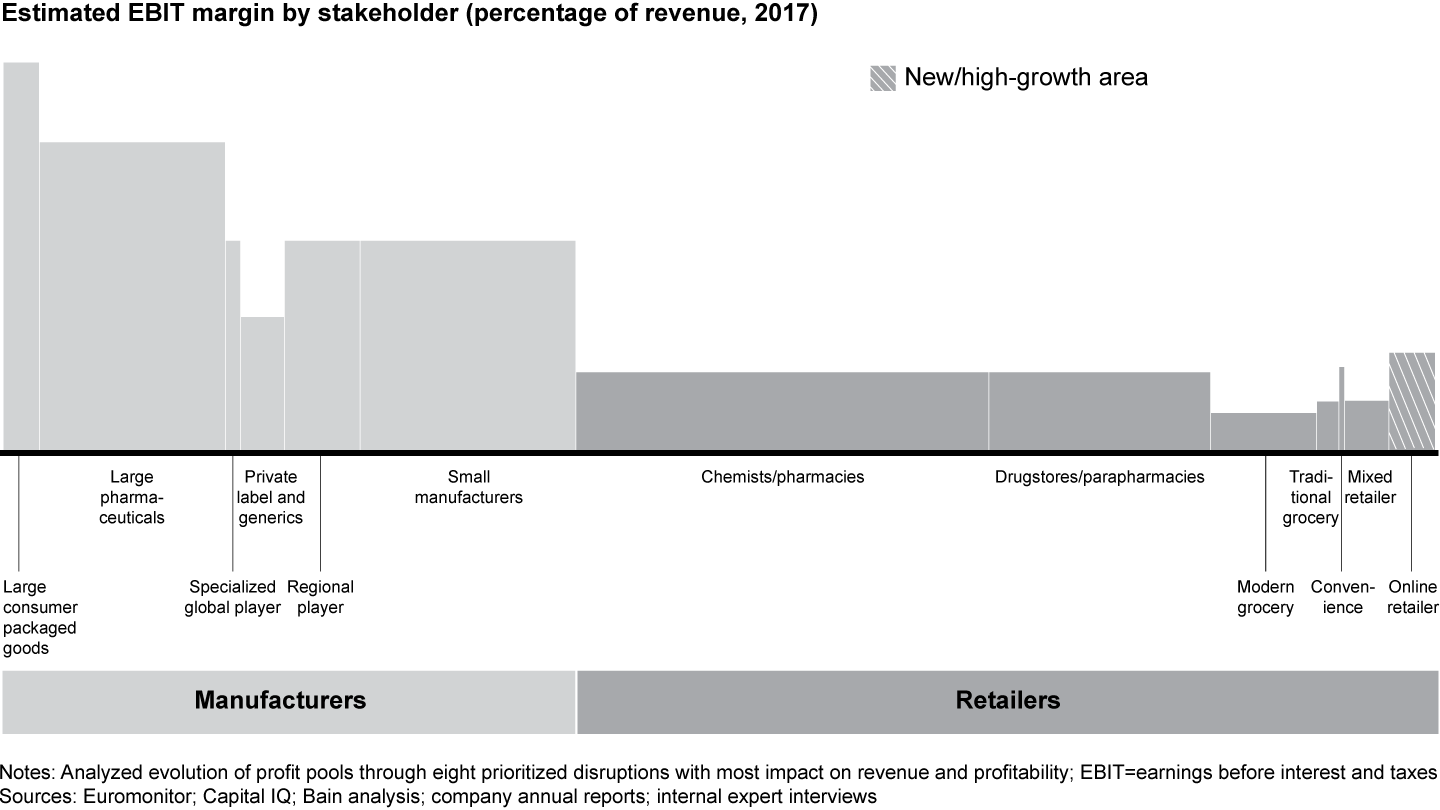

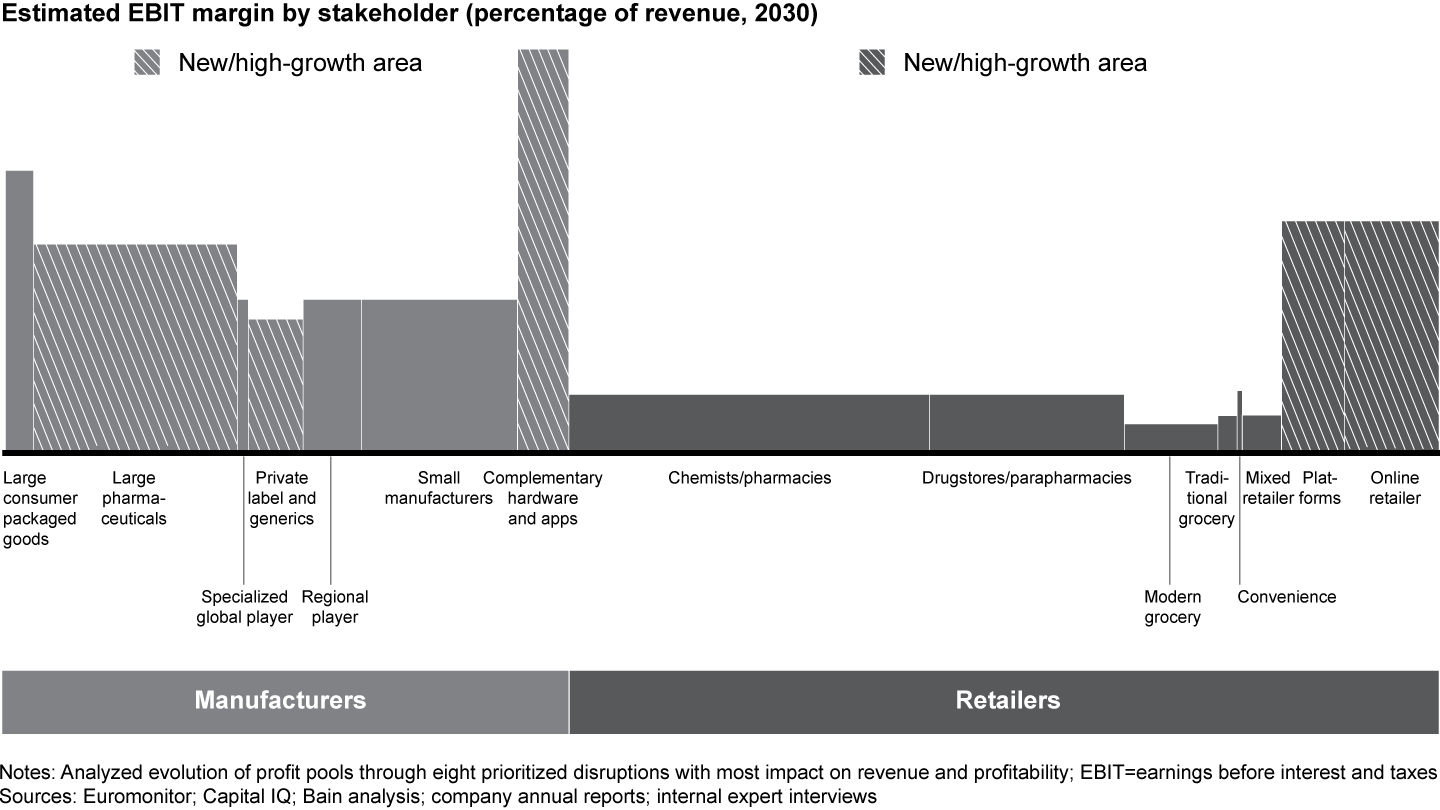

Social listening, artificial intelligence and other tools can be deployed to detect growing trends by picking up signals from vast amounts of unstructured data (see Figure 4). Also, category-specific analysis of venture capital and private equity investment flows shows where bets are being placed, highlighting new brands and exciting innovations. Fact-based methodology then helps to prioritize trends by considering analogies in other categories, benefits to consumers, technological plausibility, and potential incremental impact on both revenue and cost.
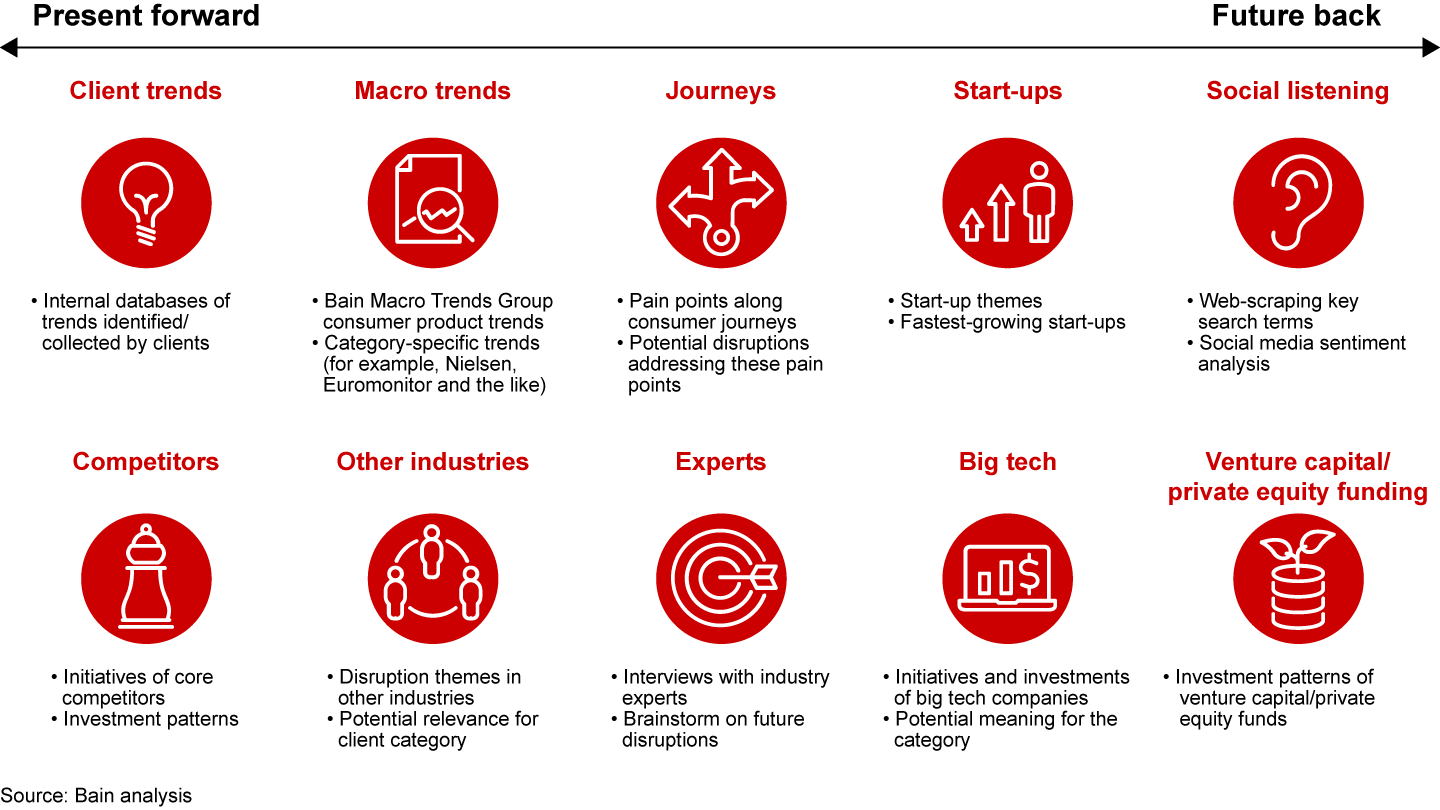

In the over-the-counter pharmaceuticals space, one future-back scenario of the profit pool shows customer-turned-competitor Amazon capturing share from branded players and driving down prices; however, it also shows complementary hardware and apps, such as real-time health tracking, as new and growing segments. Those are big opportunities among the threats.
The leading companies devise and quantify multiple views of the future—for instance, one in which sugar regulation intensifies and one in which it subsides. They can determine how much money is at stake if they do nothing, how much opportunity lies ahead and set a course of action, either offensive or defensive.
“Waves” and “stepping-stones”
Setting that course of action becomes a new game. Traditionally, brands develop a pipeline of projects with set timelines and milestones, but a far more Agile approach that allows for constant reevaluation based on updated findings and permission to pivot will replace this existing “set it and forget it” methodology. This nimble approach is challenging for many incumbent companies, but it is at the heart of how digital natives build winning positions.
Some of the most successful companies now use “waves” and “stepping-stones” to create and communicate a roadmap. Waves are the successive evolutions that lead a business toward the future it envisions. Stepping-stones don’t mean making progress one step at a time; rather, stepping-stones are meant to convey the idea that you don’t see step two until after you take step one. The key is moving forward, pivoting as needed, then moving forward again.
If this sounds daunting, remember how Uber launched not as a ride-hailing pioneer but as an on-demand black-car app, a relatively simple idea. It was only after Uber had its platform in place that the company could connect to a large group of drivers sitting in their cars. Subsequent waves of innovation enabled drivers to use their own cars, offer UberPool ride sharing and, most recently, experiment with self-driving cars. We now see further waves of innovation using that network not only as drivers but also as a delivery service. Netflix started as a subscription DVD delivery service, then added online subscription and streaming, and now develops award-winning original content. Ocado, a UK-based online grocer known for its high-quality food, now identifies itself as a robotics and logistics company. None of these companies knew what the future would hold, but they ensured a dynamic roadmap and pivoted as they identified threats and opportunities.
Four fundamental moves to get started
Disrupting an industry, as opposed to being disrupted by it, requires choosing what to prioritize and ensuring that those few priorities are appropriately funded and supported. Consumer goods companies can take practical steps to find their future.
Reset how you think about “category.” That means starting from future consumer needs and profit pools, not the product set of today. Coca-Cola flourished for decades as a leader in carbonated soft drinks but realized that future growth depended on its ability to embrace a world in which consumers are seeking healthy, low- and no-sugar options. The company is reshaping its growth strategy and operating model in line with changing consumer tastes and buying habits. Coke is becoming a “beverages for life” company, a shift from a carbonated soft drinks company, broadening its portfolio in five category clusters, including sparkling, energy, dairy/juice/plant-based, water/enhanced water/sports drinks, and ready-to-drink coffee and teas. The company’s venturing and emerging brands unit identifies and invests in emerging beverages, using Coke’s market insights, commercial capability and distribution muscle to help it scale brands such as Honest Tea. The beverage company also has made it a priority to address changing consumer needs and occasions by expanding the availability of smaller packaging such as mini cans.
Develop models for entrepreneurship. As part of the today-forward and future-back approach, successful consumer goods companies are getting out ahead of disruption by liberating part of the organization to move at a greater pace and encouraging a buy mentality vs. a build mentality. Unilever’s beauty and personal care division aggressively acquires small brands that can enhance its prestige businesses, which are defined not necessarily by high price points or channels but rather by business models that focus on superior consumer experiences. Unilever even runs competitions to discover and vet such promising brands.
Build platforms, not products. Again, the best companies acknowledge that products, channels and business models are increasingly blurred. Glossier aptly describes itself as a “people-powered beauty ecosystem.” Emerging from millennial founder Emily Weiss’s beauty blog, the young cosmetics company has turbocharged growth by remaining astoundingly close to its consumers and their needs through social media—at last count, it amassed at least 2 million Instagram followers—fostering fierce loyalty and a strong sense of community. That community validates the company’s products—even its packaging design promotes Instagramable “shelfies”—while user-generated content provides feedback and insights that lead to product innovation. The emphasis on two-way communication facilitates cocreated beauty products that, as the company’s tagline says, are “inspired by real life.”
Create new advantages of scale. While many of the classical benefits of scale have drastically changed in recent years, we still believe that being big has essential advantages that need to be rediscovered, reclaimed and redeployed. For instance, incumbents have an advantage when it comes to accessing external networks and establishing stronger partnerships with third parties that will always favor scaled relationships. Increasingly important, big companies can generate better business insights via their prime position to access big data. While lower barriers do ease the entry of smaller brands, algorithms help push the most famous, most often requested and top-of-mind brands. Also, ratings, reviews and blogs are boosting the power of the savvy big brands that have mastered the art of digital.
Real transformation goes deep and sounds overwhelming, but it can be done—digital natives and incumbents both are making it happen. Bain Radar 360 Strategy SM helps leadership teams to focus their efforts and investments, enabling companies to play offense with innovation and defend against disruption with a radically new approach to strategy that defines what you can do today and how it will shape your advantage years from now.
Methodology: Six Ways to Predict Disruption
We use six lenses to explore the impact of disruption in consumer products (see Figure 5). Each lens focuses on a key theme. Looking through the lenses allows us to imagine disruptions as well as future innovations and business models. For example, through the “shifting ecosystems” lens, we imagine a category future in which products, services, experiences and communities blur, new channels appear, and concepts such as the sharing economy or secondary markets expand to new categories.
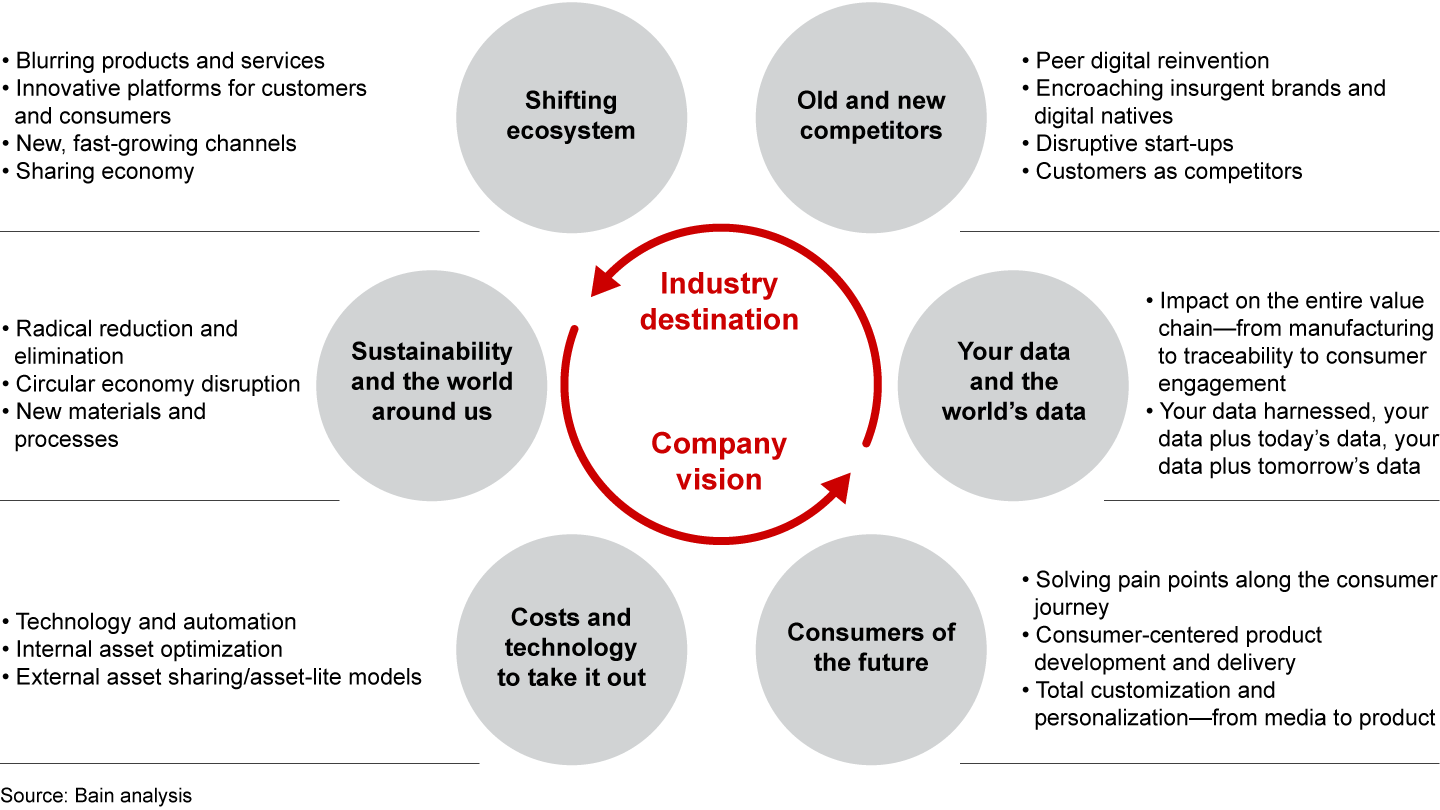

This approach helped us determine how a dairy company could use the “your data and the world’s data” lens to see how blockchain technology would enable total transparency and traceability. The company could develop a plan to meet consumer demand for local, traceable milk and ultimately catch contamination before it reaches supermarket shelves.
Relying on “consumers of the future,” “old and new competitors” and “shifting ecosystems” lenses, a consumer health company envisioned a future in which trade customers continued to become competitors and winning would require developing direct-to-consumer community platforms for niche audiences.
The “sustainability and the world around us” and “consumers of the future” lenses were the starting point for a beverage player to see the need for new, sustainable delivery models, including plastic-free, fully circular or reusable packaging offered through new distribution points to satisfy the on-demand consumer culture.
Francois Faelli, a Bain & Company partner based in Brussels, leads the firm’s Global Consumer Products practice. Richard Webster and Emron Pratt are Bain partners based in London and Washington, respectively, and members of the Consumer Products practice. Leah Johns is a Consumer Products practice manager based in London.
Bain Radar 360 Strategy℠ is a service mark of Bain & Company, Inc.